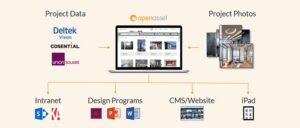How to Overcome Bid Burnout
Dec 1, 2022

From pulling all-nighters to wrestling content out of technical staff, proposal professionals shoulder immense stress in the pursuit of winning the work that keeps businesses functioning. When left unchecked for prolonged periods, that burden eventually results in burnout. This proposal and RFP management guide has everything you need to manage proposal team burnout.
Tips and Tricks to Fight Proposal Burnout in the AEC Industry
For many proposal professionals, high-stress bids, difficult SMEs, long hours, and race-to-the-finish-line submissions are just part of the job. It’s the life they’ve chosen, and while it’s incredibly rewarding, it comes with a dark side that many of proposal professionals battle in silence.
For years, burnout has been a taboo subject among proposal professionals. It’s hidden behind the mantra of “that’s just how it is”. Too many of these overworked professionals are afraid to speak up either out of fear of retaliation or fear of being the only one – the weak one – that can’t handle the pressure.

We’ve seen our colleagues and clients put themselves in the hospital – their bodies physically buckling under the prolonged stress. We know what it’s like to be alone in the office at 3:00 in the evening, finalizing a proposal due at 10:00 a.m. the next morning.
We’ve missed holidays, birthdays, soccer games, and graduations – moments with family and friends that we’ll never recover. Fortunately, there are ways to battle proposal burnout – to make your life just a little bit easier, and reclaim those precious moments in your life.
Why We Need to Talk About Burnout
A 2018-2019 APMP Ethics Survey Report showed that 8 in 10 proposal professionals reported being burnt out and overworked. That burnout comes at a high cost to the individual, their team members and their employer. It’s estimated that burnout costs organizations $190 billion annually from:
- lost productivity,
- absenteeism,
- lower organizational commitment, and
- turnover.
On an individual level, burnt out employees that disengage cost their employers approximately 34% of their annual salary due to missed worked days and decreased productivity. Burnout also accounts for between 20% and 50% of employee turnover, which brings additional costs for hiring and training new employees.
For individuals, though, the cost of burnout isn’t just monetary, it takes a severe mental toll on the individual and often leads to serious physical and mental health issues.
Burnout vs. Stress: How Do I Know if I’m Burnt Out
Any proposal professional will tell you that they are accustomed to managing stress in their daily activities. Unfortunately, it can be rather difficult to know when they’ve crossed over from “stressed” into “burnt out” territory.
What is the Difference Between Burnout and Stress
Burnout and stress are related, but the key difference is that stress is usually temporary, while burnout is persistent. For example, we may feel stressed when a proposal deadline approaches. That stress may cause us to be anxious and hyper-focused on completing our final tasks.

However, once the deadline passes, that stress tends to dissipate. The anxiety should go away, and that sense of urgency or hyperactivity should settle back into a normal pattern of engagement with our work.
Burnout, on the other hand, can leave you feeling unmotivated, drained and unwilling to complete the proposal. You might also feel helpless, trapped in an endless cycle of proposal deadlines and chronic stressors with no way out. As a result, you begin to disengage with your work, no longer invested in the success or outcome of the next proposal.
| Symptoms of Stress | Symptoms of Burnout |
|---|---|
| Over-engaged | Disengaged |
| Reactive | Detached/distant emotions |
| Sense of sustained urgency/hyperactivity | Irritable/irrational |
| Slumps in energy | Sense of helplessness |
| Anxiety | Loss of motivation |
Common Causes of Burnout Among Proposal Professionals
There are several common causes of burnout among proposal professionals. These chronic stressors include lack of control, unclear job expectations, workplace dynamics, chaotic activity, lack of social support, and work/life misalignment.
Lack of Control
Proposal professionals don’t always have autonomy over their roles. The inability to make or influence decisions about schedule, assignments, or workloads often lead to burnout. A lack of resources necessary to complete their work, whether that’s adequate staffing or the appropriate tools to deliver a proposal, can also contribute to burnout.
Unclear Job Expectations
In the architecture, engineering, and construction (AEC) bid and proposal world, proposals are often assigned to “marketing” professionals that also manage other communications tasks for a company. It can sometimes be unclear what the priorities of a marketing professional are and how much authority they have over their various roles and tasks. When proposal professionals aren’t certain about what management or colleagues expect of them, they feel uncomfortable at work. This persistent discomfort can lead to burnout.
Workplace Dynamics
Proposal professionals aren’t the only ones that may not be clear on their job expectations. Technical staff and managers that don’t understand their role (or the proposal professional’s role) in producing a proposal may undermine or micromanage the process or introduce additional work that puts further stress on the proposal professional.
Chaotic Activity
Proposals can be high-stress activities, especially without effective processes in place to manage their production. Proposal professionals that expend constant energy to engage in these activities will eventually fatigue and burnout.
Lack of Social Support
Proposal professionals may feel isolated at work, uncertain if they should (or can) say anything about their chronic stressors. Many proposal professionals also struggle to explain their roles and stressors to those in their personal lives, which may increase feelings of isolation. This emotional stress can also contribute to burnout.
Work-life Misalignment
Work is a central part of life. But for proposal professionals, work may begin to take up so much time and effort that they no longer have the energy to spend time with family or friends. That time outside of work helps us to recharge; without it, we’re on the road to burnout.
Conflict and Conflict Avoidance
Conflict avoidance is likely the root cause of burnout for proposal professionals. We may realize that we don’t have the necessary resources or authority to do our job well, but we choose not to say anything out of fear of retaliation.
Perhaps we have spoken up and noted to management that a particular coworker is creating issues with the proposal process, but our complaint has been dismissed or met with hostility. Perhaps this happened at a previous workplace, but we carry that fear with us into our new role and remain silent to avoid conflict.
Common Symptoms of Burnout: What Happens if I Burnout

Burnout, like stress, has stages and levels. If we catch it early, it may only take a few weeks of recovery to get back to a normal level of energy again. If we wade, though, and let our burnout reach an extreme, it can take months to recover – and that recovery may just happen in a hospital. If you experience any of the following symptoms, you may be experiencing burnout.
- Fatigue
- Insomnia
- Sadness, anger, irritability
- Heart disease
- High blood pressure
- Vulnerability to illnesses
What Can I Do To Get Over Burnout
If you feel burnt out or that you may be on the edge of burning out, it’s time to stop and assess your situation. Take a step back and create space for yourself before you start planning your next steps. It’s important to take a pause to understand what you need because plunging straight into addressing the causes of your burnout can feel overwhelming and possibly further contribute to your burnout.
Eventually, you’re going to have to make a plan to prevent future burnout, but for now, you need to postpone any important decisions or discussions until you have the energy and the neutrality to do so.
Step One: Address Your Needs and Make an Emergency Plan
Start by addressing your needs and making an “emergency plan.” Many proposal professionals facing burnout have sacrificed sleep, healthy (or even just regular) meals, exercise, and downtime for their jobs. If you’ve burned out, you need to address these issues and re-establish regular sleeping patterns, regular meals, movement, and time to relax.

This may be the hardest part of addressing burnout, because if it were easy to re-establish healthy behaviors, you would have done it already, right? The difference between the need to establish those behaviors now and the need to establish them pre-burnout is motivation.
During pre-burnout – when you’re in the “just stressed” category – you still have the energy to expend on work. Of course, you’re borrowing that energy from other parts of your life that you’ve given up.
Now that you’re burned out, there are no other energy reserves for you to borrow from. Without an emergency plan, your body will eventually start to feel the physical effects of burnout, like fatigue and even serious illness.
How to Create an Emergency Plan to Avoid Burnout
Your emergency plan can be simple but should include the following steps:
- Re-establish a Regular Sleeping Pattern – Create work “buffers” in the morning and evening, allowing yourself to not work or check emails for an hour or two before bed and after waking up.
- Eat Regular Meals and Prioritize Healthy Food – The goal at this stage is to nourish your body, which has been neglected over time.
- Make Time for Movement – Go for a walk, head to the gym, sign up for dance classes, surf, play tennis, or whatever it is that gets you moving. Exercise is a mood booster and great for grounding you in the moment.
- Give Yourself Permission and Time to do Things You Enjoy – It’s okay to start small, especially when you’re adjusting to the idea of not being constantly available to your team. You might take fifteen minutes of your lunch hour to read or set aside the hour after you’re done with work for the day to silence notifications and knit, draw, or whatever it is you like to do.
- Take Note of Your Energizers and Your Stressors – Listing activities that build your energy (like eating a good meal, visiting with friends, walking the dog) and those that drain your energy (like household chores, work meetings, difficult team members). Prioritize energy-building activities during your burnout recovery.
Your emergency plan does not need to be extensive. Simply put, it is a plan to rebuild your energy stores through healthy activities for your mind and body.
How to Protect Yourself From Burnout
Once you have regained your energy (you’ll know you’re ready when those energy-draining activities from your emergency plan seem less like mountainous obstacles and more like minor hurdles), it’s time to make a plan to protect yourself from future burnout.
Make a List of Burnout Contributors
Start by making a list of things that contribute to your burnout. Perhaps you don’t feel like you have the ability to balance your own workload, or you consistently struggle to engage a particular team member in the proposal process.
Schedule a Conversation with Management/Leadership
Next, prepare to have a conversation with management or leadership about these issues. Choose one or two of your primary concerns so that you don’t overwhelm yourself or the other person with too many problems to solve.
Start by asking permission to have the conversation, and then equip yourself with data to support your position. For example, if one of your burnout contributors is an overwhelming workload, come prepared with data on the number of hours your average assigned tasks require, as well as data on the number of overtime hours worked to complete recent proposals.

Remember that it will be easier for management to understand statements like “I averaged 65 hours a week for the past four months” than it will be for them to understand “I averaged 6-8 proposals a month for the past four months.” Not everyone will understand the time or effort a proposal requires, but they will understand the hours on your timesheet.
If you have recommendations for solutions, now is the time to suggest them. If you have data to support hiring another full or part-time position is warranted (for example, you consistently work 20-40 hours of overtime a week), it will be easier to sell your solutions. Finally, remember to thank the other person for listening to you.
Remember That It’s All Practice
The final part of preventing burnout is understanding your own boundaries and communicating them to your team. This can take practice, just like having difficult conversations with management about burnout will likely take practice.
If you don’t establish your boundaries, no one else is going to know what they are. If you sacrifice your lunch hour or say yes to “saving the day” with last-minute proposal edits consistently, you are communicating to your team that it is okay for them to continue asking you to give up your time. Once they expect you to be able to pull a proposal together in 24 hours or race to format a submission over your lunch hour, it can be incredibly difficult to break the behavior.

That’s where practice comes in. We practice saying, “no, it’s just not possible to make these revisions within normal working hours,” “no, I will not be available while I’m on vacation with my family,” or “no, I am not taking my work laptop home with me for the holiday.”
It won’t be easy, especially the first few times. You may start by saying, “no, I won’t be available while I’m on vacation,” but end up working in the airport and shutting down your computer once you arrive at your destination. You might start by saying, “no, I will not give up my lunch hour to format this proposal,” but cut your lunch hour short to make the formatting changes.
It’s okay to practice. It’s okay to take small steps. Burnout recovery and prevention is about taking care of yourself, and that looks different for all of us, depending on our boundaries and our unique situations.
Implement a Digital Asset Management (DAM) System
The best way to avoid and manage burnout as a proposal professional is to prioritize yourself, your needs and your physical wellbeing. The second best thing you can do is take steps to make the proposal process easier, less stressful and more collaborative.

Fortunately, there are tools available that make the proposal, bid and RFP response process easier to manage, more efficient and more effective. One such tool is a digital asset management (DAM) system, which enables organizations keep and utilize the digital assets they need to grow their brand, empower their sales teams, and disseminate a clear and purposeful message to their audience.
How to Get Started with DAM: Contact OpenAsset for a Free Demo
Unlike traditional DAM systems, OpenAsset is a project-based digital asset management solution specifically designed for AEC marketers. With dozens of integrations and useful features, OpenAsset is the martech you need to create high-converting content, proposals, presentations and much, much more. Contact OpenAsset today to get started with your free demo.





